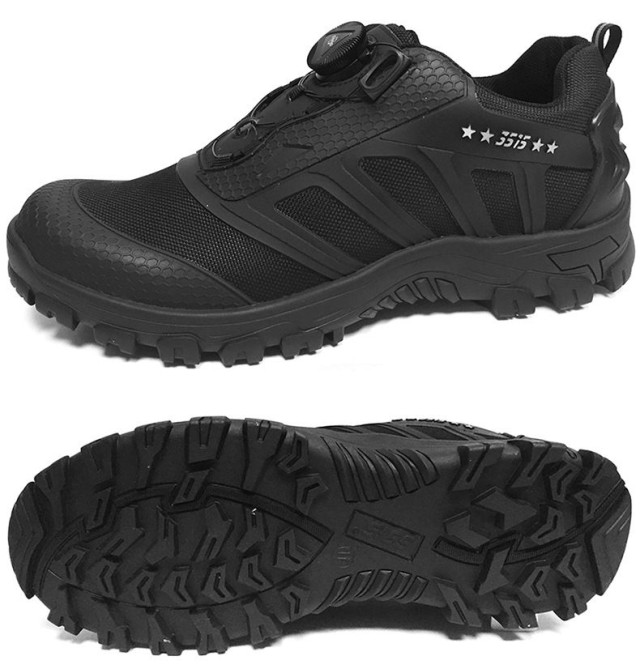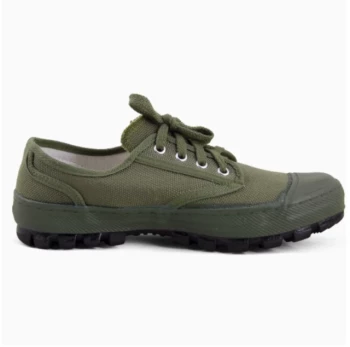Every year, workplace slips account for over 20% of occupational injuries—many preventable with proper footwear. This guide deciphers how tread patterns, rubber softness, and sole engineering combine to create optimal slip resistance for your specific environment.
The Science Behind Slip-Resistant Footwear
Slip-resistant shoes aren’t just about textured soles. Three elements work synergistically:
How Tread Patterns Tackle Different Surfaces
- Wet floors: Multi-directional grooves (like hexagonal or wave designs) disperse liquids 40% faster than straight channels, reducing hydroplaning risks.
- Oily surfaces: Micro-sipes (hairline fissures in the rubber) create suction-like grip, proven to improve traction by up to 30% in industrial kitchens.
- Outdoor terrain: Deeper lugs (4mm+) prevent mud/snow buildup, while staggered spacing maintains ground contact on uneven paths.
Key Insight: Avoid large, circular treads—they trap liquids underneath like a car tire on wet pavement.
Why Rubber Softness Isn’t One-Size-Fits-All
Rubber durometer (hardness) directly impacts performance:
| Environment | Ideal Hardness (Shore A) | Rationale |
|---|---|---|
| Hospital floors | 50–60 | Softer rubber molds to slick tiles |
| Construction sites | 70–80 | Firmer resists punctures on debris |
Pro Tip: Test flexibility—bend the sole. If it resists slightly but yields under pressure, it balances grip and durability.
Matching Sole Design to Hazard Types
Hydroplaning Prevention in Wet Workplaces
Food processing plants and hospitals need soles that:
- Channel liquids outward: Chevron or zigzag patterns push water to the sides.
- Include rounded edges: Reduces "seal effect" where liquids get trapped under flat soles.
Real-World Impact: A 2022 study showed kitchens using channeling treads reduced slip incidents by 60% versus flat soles.
Traction Demands for Uneven Outdoor Terrain
For landscapers or warehouse workers:
- Self-cleaning lugs: V-shaped treads shed gravel/mud automatically.
- Wide contact area: Spreads weight to prevent sinking in soft ground.
Caution: Deep treads excel outdoors but collect grease indoors, becoming hazards themselves.
Industry Insights and Real-World Validation
How OSHA Standards Influence Sole Engineering
OSHA’s Walking-Working Surfaces Standard (1910.22) mandates:
- Static friction coefficient (SFC): ≥0.5 for level surfaces (most rubber soles meet this).
- Slope-adjusted SFC: ≥0.6 for ramps—achievable with softer rubber (Shore A 55–65).
Myth Buster: "Slip-resistant" labels aren’t regulated—always verify tread design and rubber specs.
Case Study: Slip Reduction in Hospital Corridors
A Midwest hospital switched to:
- Soles with 55 Shore A rubber
- 3mm hexagonal treads
Result: 72% fewer nurse falls in 6 months, saving ~$200,000 in injury claims.
Your Next Steps
No shoe eliminates all slip risks, but the right rubber sole turns "accident-prone" into "accident-proof."
For Distributors & Bulk Buyers: 3515’s engineered soles combine OSHA-compliant treads with environment-specific rubber compounds. Let’s collaborate on footwear that protects your clients’ teams—and their bottom line.
Final Tip: Pair quality soles with clean workspaces. Even the best shoes can’t overcome oil slicks or cluttered walkways.
Related Products
- Durable High-Traction Canvas Sneakers Wholesale & Custom Manufacturing
- Durable Rubber Sole Outdoor Shoes Wholesale & Custom Manufacturing
- Factory-Direct Wholesale Canvas Boots with High-Traction Rubber Soles
- Durable Canvas Work Shoes with Rubber Lug Sole | Wholesale Manufacturer
- Durable Rubber-Soled Utility Shoes for Wholesale & Custom Brand Manufacturing
Related Articles
- How Rubber-Soled Shoes Master All Seasons: The Science of Traction and Adaptability
- How to Choose Slip-Resistant Rubber-Soled Shoes for Maximum Safety
- How to Choose Rubber-Soled Shoes That Actually Prevent Slips and Falls
- Blake Stitch vs. Goodyear Welt: Decoding Durability, Repairability, and Ideal Use Cases
- How to Choose Business Casual Shoes: Style, Material & Workplace Pairing Strategies
















